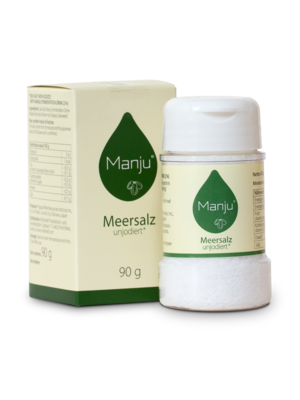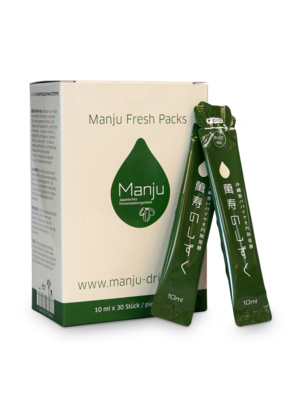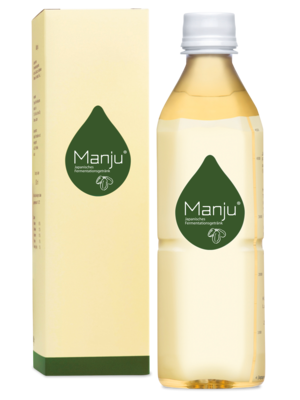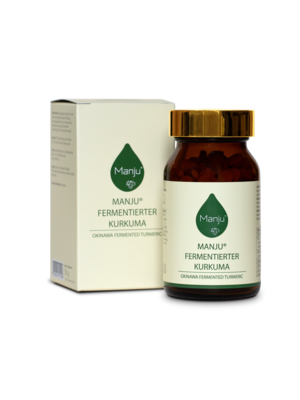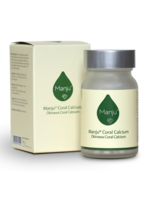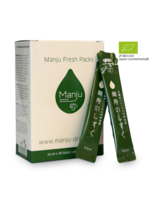

Manju - Drops of life
Unleash the power of nature with Manju
Manju - a melodious name. The name "Manju" comes from the precious green papaya, which in Japan is called the "melon of ten thousand years of life". Nowhere else in the world do more centenarians live than on the Okinawa Islands to the south-west of Japan. They use plants as medicines in their diet, for example the green papaya. The power of this fruit and other valuable ingredients are combined in a complex process in the fermentation drink Manju. The ingredients are just as diverse as the various applications of Manju. Whether cold or warm, pure or in food or drink - Manju can be easily integrated into everyday life.
Manju Products

The advantages of Manju at a glance
- Use of exclusively natural ingredients
- Fermented with special microorganisms in a one-year process using state-of-the-art technology
- Easy application of Manju in everyday life
Tiny microorganisms have a big impact
What does your well-being have to do with microorganisms? They are invisible to the naked eye and yet they are everywhere: microorganisms. And they are not only around you, they also live in you - just like in all other people, animals and plants in the world. Here you can find out why these tiny fellow inhabitants are so important for human well-being and therefore the Manju effect.
Microorganisms can be found everywhere
The importance of microorganisms was unknown for a long time. Since their discovery, bacteria in particular have been equated with diseases and have therefore been fought on a broad front: with disinfectants and antibiotics. But this view is changing dramatically. The latest research results from all over the world show the major role played by microorganisms. Their scientific exploration has opened up completely new horizons in medicine and other fields. Microorganisms play a major role. Because it suddenly became clear that, strictly speaking, humans are a changing ecosystem. It is an incredibly diverse biotope on whose inner and outer surfaces thousands of different types of bacteria, viruses and fungi have their effect.

The story and effect of Manju
Two facts stood at the beginning of the history of this all-round healthy drink: the fact that the inhabitants of the island in the Pacific Ocean astonishingly often reach an age of over a hundred years, and the commitment of one man, Tô'ichirô Nago, who founded the agricultural research institute Tropical Plant Resources Institute (TPR) on this island in 1989. Tô'ichirô Nago and his team set themselves the goal of improving organic farming methods on Okinawa and researching the effects of plants used for medicinal purposes. One of these plants is the green papaya, a tropical plant with extraordinary effects that thrives in this region. Based on this ancient knowledge, TPR has developed a drink that has many positive effects on the human organism. The green papaya, brown rice, rice bran, seaweed and Effective Microorganisms specially selected for food production are the raw materials from which the healthy drink is made. After extensive basic research, the institute now knows that the choice of precisely these ingredients was the right one. This and the year-long fermentation and production process result in the high quality of Manju.
Two facts stood at the beginning of the history of this all-round healthy drink: the fact that the inhabitants of the island in the Pacific Ocean astonishingly often reach an age of over a hundred years, and the commitment of one man, Tô'ichirô Nago, who founded the agricultural research institute Tropical Plant Resources Institute (TPR) on this island in 1989. Tô'ichirô Nago and his team set themselves the goal of improving organic farming methods on Okinawa and researching the effects of plants used for medicinal purposes. One of these plants is the green papaya, a tropical plant with extraordinary effects that thrives in this region. Based on this ancient knowledge, TPR has developed a drink that has many positive effects on the human organism. The green papaya, brown rice, rice bran, seaweed and Effective Microorganisms specially selected for food production are the raw materials from which the healthy drink is made. After extensive basic research, the institute now knows that the choice of precisely these ingredients was the right one. This and the year-long fermentation and production process result in the high quality of Manju.

Manju - The power of nature for an inexhaustible immune system
The overwhelming majority of these microorganisms are completely harmless. On the contrary: humans can only exist together with these trillions of microorganisms. They are something like a human "super organ". This organ, also known as the microbiome, is connected to our own body cells and organ systems in many ways. Our body cells and the microorganisms in our body form a peaceful symbiosis from which both benefit. Everyone involved benefits from this complex, lively co-operation and intensive alliance. Trillions of microbes could never colonise us if they didn't benefit themselves. We benefit them and they benefit us. For example, they ensure smooth digestion, a healthy protective skin layer, a stable immune system, as well as mental well-being and good memory performance. The majority of microorganisms live in the lower small intestine and large intestine.
What role does the "gut" microbiome play for us humans?
Our gut is a huge ecosystem made up of around 100 trillion microorganisms. It has long been underestimated as an organ. However, it is definitely much more than just a digestive tube. In fact, it builds up a large part of the immune system and regulates countless metabolic processes. As our body's central energy source, it influences all other organ and functional systems, such as our skeleton, our skin and our psyche. In order to be able to fulfil all these tasks, the intestine or the body is absolutely dependent on the intestinal microbiota (formerly known as intestinal flora). But this microbiome as a bacterial organ is more than just the sum of the individual bacteria. The composition of the gut microbiome not only influences our physical health, but also how we think, feel, communicate, learn and behave.
Our gut is a huge ecosystem made up of around 100 trillion microorganisms. It has long been underestimated as an organ. However, it is definitely much more than just a digestive tube. In fact, it builds up a large part of the immune system and regulates countless metabolic processes. As our body's central energy source, it influences all other organ and functional systems, such as our skeleton, our skin and our psyche. In order to be able to fulfil all these tasks, the intestine or the body is absolutely dependent on the intestinal microbiota (formerly known as intestinal flora). But this microbiome as a bacterial organ is more than just the sum of the individual bacteria. The composition of the gut microbiome not only influences our physical health, but also how we think, feel, communicate, learn and behave.

How can we strengthen the microorganisms with the use of Manju?
We have around two kilograms of microorganisms in our gut. We ourselves can do a lot to ensure that they feel at home and have a positive influence on our health. We can support our gut bacteria by eating a microbiome-friendly diet: high in fibre, balanced but predominantly plant-based, lots of fermented foods, as little sugar and white flour products as possible. If necessary, it is good to take specific pre- and probiotics.

